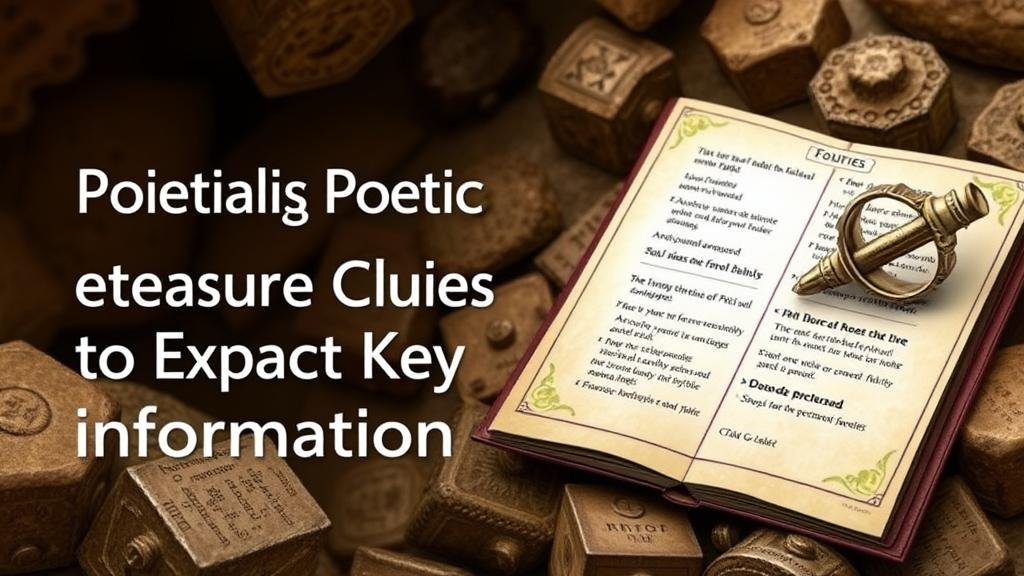Identifying Poetic Structures in Treasure Clues to Extract Key Information
Identifying Poetic Structures in Treasure Clues to Extract Key Information
Deciphering treasure clues can often feel akin to interpreting complex poetry. Both fields rely heavily on the use of structure, rhythm, metaphor, and form to convey deeper meanings and hidden information. This article delves into how poetic structures can be identified in treasure clues, providing practical strategies for extracting key information.
The Importance of Poetic Structures in Treasure Clues
Poetic structures play a crucial role in treasure hunting as they shape how clues are delivered and interpreted. Poets use various devices such as rhyme, meter, and enjambment to create resonance and emphasis, a technique that treasure clue creators often mimic. Identifying these structures can illuminate the texts underlying significance, guiding treasure hunters to appropriate actions or locations.
Common Poetic Devices Found in Treasure Clues
Several poetic devices frequently appear in treasure clues. Understanding these can aid in deciphering meanings that are not immediately apparent. Below are some of the most common:
- Alliteration: The repetition of initial consonant sounds can create emphasis. For example, Find the fluttering flag might suggest a location where flags are present.
- Metaphor: This device equates two unlike things to present a new understanding. A clue might say, Where the sun meets the ocean, implying a coastal area rather than literally suggesting an intersection.
- Rhyme Scheme: Determining the rhyme pattern can help predict the next line or idea. A couplet may indicate a pair of coordinates or related items.
- Imagery: Vivid descriptions often contain sensory details that can provide critical contextual clues. For example, beneath the whispering leaves may suggest searching in a wooded area.
Analyzing Clues: Step-by-Step Methodology
To effectively extract information from treasure clues, employing a systematic analysis method is essential. The following steps can be utilized:
- Initial Reading: Read the clue thoroughly to grasp the overall message.
- Identify Structure: Look for poetic devices and identify the structure type–sonnet, haiku, rhyme scheme, etc.
- Contextual Comparison: Relate the identified structure to known literary examples or historical contexts.
- Interpret Meaning: Analyze the metaphorical implications and extrapolate the potential location or action.
- Field Application: Use the findings through physical exploration or additional research.
Case Study: The Poe Treasure Hunt
A notable example of using poetic structures in treasure clues can be found in the renowned Poe treasure hunt, orchestrated by author Andrew Emblow in 2004. Emblows clues interwove poetic forms, historical references, and literary allusion, challenging participants to unlock their meanings.
One of the clues read, In the rectangle where shadows merge, look to the east of the bridges surge. Upon analyzing the structure, treasure hunters recognized the alliteration of s sounds and the reference to a specific location–a park featured in Poes works. This prompted a focused search near the banks of the chosen body of water.
Real-World Applications of Poetic Analysis
The principles of identifying poetic structures extend beyond literary realms into various fields. Here are some areas where these analytical skills can be particularly useful:
- Coded Messages: In cybersecurity, professionals often turn to poetic structures to decode cryptic messages that rely on rhythmic patterns.
- Marketing: Advertisements often use poetic devices to make slogans memorable; understanding these techniques can aid in crafting impactful messages.
- Education: Teaching students to recognize poetic devices in lyrics and literature can enhance their analytical skills.
Actionable Takeaways
To wrap up, identifying poetic structures in treasure clues enriches the treasure hunting experience by revealing hidden dimensions within the text. Here are some actionable takeaways for aspiring treasure hunters:
- Familiarize yourself with common poetic devices and their meanings.
- Practice analyzing different types of poetry to enhance interpretation skills.
- Use a structured methodology when approaching treasure clues.
- Engage with historical contexts and literary traditions to draw connections.
Through these strategies, individuals can hone their ability to extract vital information from clues cloaked in poetic language, unlocking doors to new adventures and discoveries.



